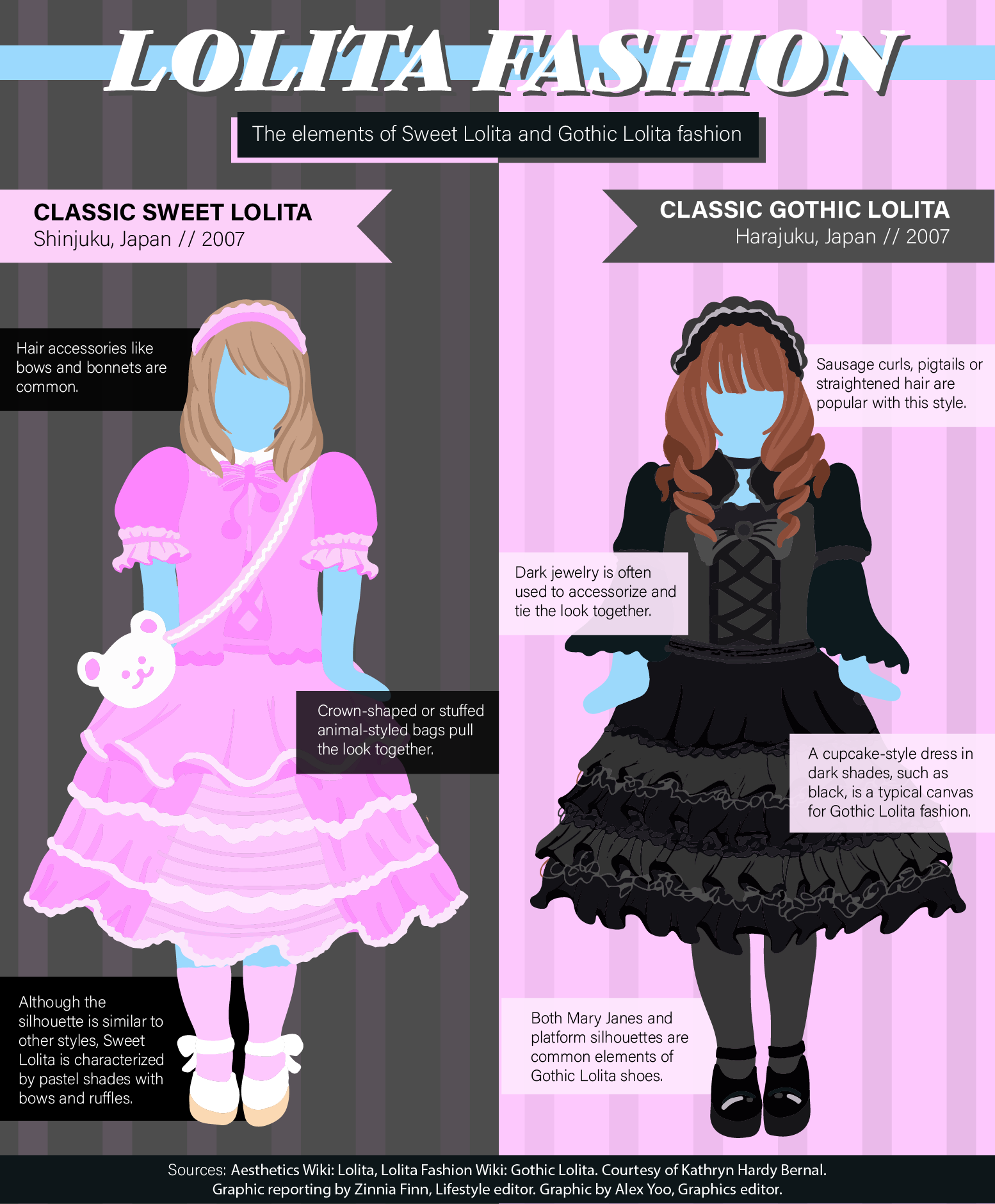Coterie Couture: Lolita fashion combines European elements with Japanese flair

By Natalie Brown
Nov. 3, 2021 9:26 p.m.
What someone wears speaks volumes about who they are as a person, and the same can be said for the styles associated with various movements and cultures. As a cyclical art form, fashion – and its attached politics – almost always reemerges from the past. Follow columnist Natalie Brown in “Coterie Couture” as she chronologically explores the impact of different subcultures and their corresponding fashion each week.
Japanese street style has never been sweeter.
As one of the most popular Japanese subcultures of the 2000s, Lolita fashion swiftly traversed Asian borders and infiltrated the American mainstream, appearing on designer runways and celebrity red carpets. Comprised of a bricolage of inspirations – like the Victorian-era dolls and Rococo fashion – the history of Lolita fashion and its influence is enthralling, said Michelle Liu Carriger, assistant professor of theater and performance studies.
“Lolita is a subcultural fashion that comes out of Japan (in the) ’80s and ’90s, and really hits its stride in the 2000s,” Liu Carriger said. “It’s a look that is based around historically European fashion, shapes, silhouettes and decorative touches.”
Liu Carriger said elements of these European fashions that are played up in the Lolita subculture include big bell-shaped, knee-length crinoline skirts and motifs such as lace, ruffles, big bows and doll-like curly hair. Modesty is at the forefront of this subculture, she said, giving rise to covered shoulders, long sleeves, pairs of tights and knee-high socks for accessories. Such fashion choices are reminiscent of early 20th century children’s books, which Liu Carriger said brings an air of whimsicality to the styles.
[Related: Coterie Couture: Rave fashion embraces individualism through bold, eclectic styles]
While Lolita subculture is widely known today, there is still some academic speculation regarding its origins, she said. Contrary to popular belief, the Japanese style has nothing to do with Vladimir Nabokov’s 1955 novel of the same name. Though the fashion does evoke feelings of childlike wonder, Lolita style evolved organically over time from a fusion of various Japanese street styles, said Kathryn A. Hardy Bernal, senior lecturer in fashion design at Auckland University of Technology.
Lolita’s origins are more specifically set in the ’90s. Japanese band Malice Mizer’s lead guitarist, Mana, was responsible for popularizing the Lolita movement, wearing a self-titled Gothic Lolita get-up comprised of these European fashion motifs. This instance was the first time anyone had ascribed a title to this distinct style. Like most thriving subcultures, Hardy Bernal said an intersection point between music and fashion was crucial, helping cement both Mana and Lolita fashion’s legacy as a prominent sect today.
“The (Lolita) subculture itself grew out of the fans of Malice Mizer wearing (Lolita) fashions,” Hardy Bernal said. “Fashion designers (then) ran with that style and formally created Lolita fashion styles in their design garments with their design collections.”
Under the large umbrella of Lolita fashion exist different style subcategories, the most popular of which is Sweet and Gothic Lolita, she said. The Sweet Lolita style can be characterized by its feminine, girlish silhouette akin to the style of Alice from Alice in Wonderland. Popularized by fashion brands such as Baby, The Stars Shine Bright and Angelic Pretty, Hardy Bernal said Sweet Lolita styles boast pastel colors, candy-inspired patterns and childlike motifs.
However, thanks to Mana, the Gothic Lolita style evolved out of the Sweet Lolita style, differentiated by its additional gothic elements such as crosses, rosary beads and black shades – making it a fusion of the Sweet Lolita and the goth subculture popular at the time, Hardy Bernal said. Lolita style has ties to other subcultures, she said, and develops a local flare depending on where in the world the subculture is picked up.
Lolita fashion in these various forms can be considered a worldwide subculture today. Liu Carriger said the popularization of Lolita fashion may be due to the ability that Lolita styles provide to step outside of one’s comfort zone. By dressing up in elaborate styles, an opportunity for escaping one’s own life presents itself, she said. Due to the style’s European colonial elements, it applies to a transnational context, she said, occupying just the right balance of familiar and foreign to intrigue a diversity of audiences.
[Related: Coterie Couture: Glam rock flaunts extravagance, persists in modern ideas of superstardom]
At the heart of the Lolita subculture, however, is the community, Liu Carriger said. American Lolita fosters an idea of belonging among its participants, and while fashion is at the forefront of this community, she said the culture still plays a significant role.
“(In America,) there were no brick-and-mortar stores or street corners to go to, (in order) to meet (other Lolitas),” Liu Carriger said. “The (American Lolitas) had to build their own culture instead, with meet-ups and online internet groups.”
With the growth of the internet, online shopping and fast fashion industries, Lolita styles only stand to benefit, Liu Carriger said. Seen on celebrities from drag queens on RuPaul’s Drag Race to models in the luxury fashion industry, such as Alexander McQueen’s silhouettes, the Lolita subculture has erupted every few years, as a natural cycle of fashion, Hardy Bernal said.
“There’s a whole lot of people who want to sit outside the mainstream during times of uncertainty,” Hardy Bernal said. “Now we’re in another time of absolute uncertainty with the pandemic and political unrest (that can be seen) all around the world. People latch on to subcultures (like Lolita) when they need some kind of escape from the real world.”



